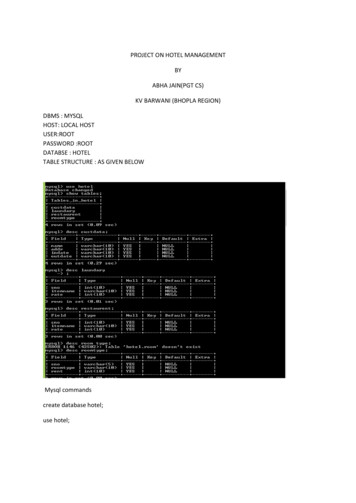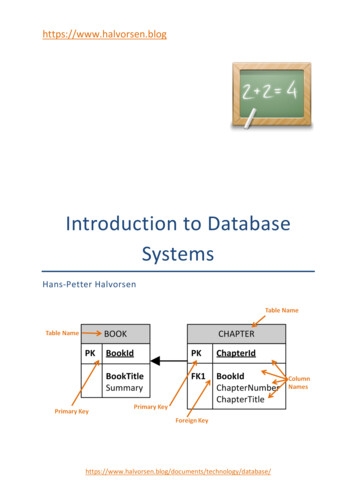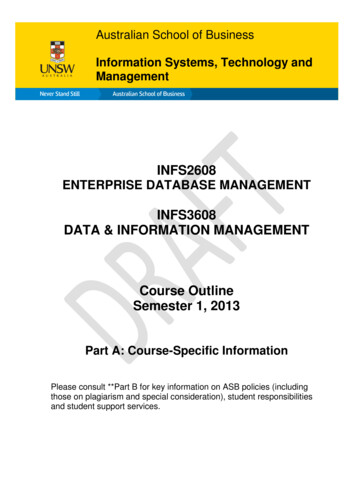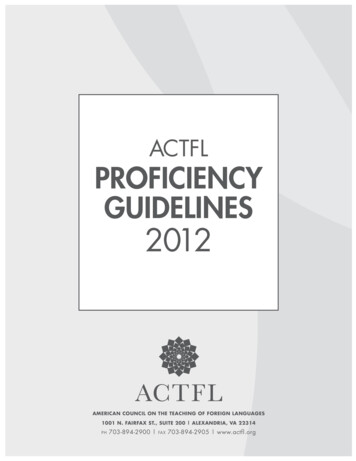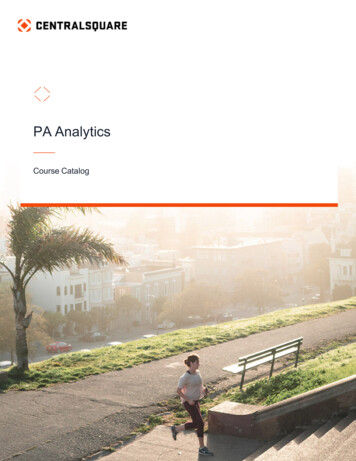
Transcription
Advanced DBMS
Advanced DBMSDr. Radványi TiborKiadó Dr. Radványi Tibor, 20112
Kézirat lezárva: 2011. január 31.ISBNKIADÓA kiadásért felel a:Felelős szerkesztő:Műszaki szerkesztő:Terjedelem: 105 oldal3
TartalomPREFACE . 6THE RUDIMENTS AND BASIC PRINCIPLES OF DATABASE ADMINISTRATION AND DESIGN . 8DATA AND INFORMATION . 8THE DATABASE . 8THE DATABASE MANAGEMENT SYSTEM . 10THE THREE LEVELS OF THE DATABASE . 10FUNDAMENTAL STRUCTURES . 13DATA MODELS . 13THE THREE FACTORS OF THE DATA MODEL . 14THE ROLE OF THE PROPERTIES . 14TYPES OF RELATIONS . 15NORMALISATION . 15Normal Forms . 16HOMOGENEOUS STRUCTURES . 19The Family Tree and the Spouse Relation . 20The Spouse Relation . 21DATABASE ADMINISTRATION . 22THE ESSENCE OF THE DATABASE . 23THE DESIGNING OF THE DATABASE . 23THE MAIN STEPS OF DATABASE DESIGNING . 23DATAMODEL ERRORS . 25FIRST STEPS IN DATABASE ADMINISTRATION . 26NOVELTIES IN MICROSOFT ACCESS 2007 . 26FORMS . 51a) Types of Queries . 57USING SQL . 62PRINT OPTIONS . 71SETTING PRINT PARAMETERS . 71PRINTER LAYOUT . 73PRINTING . 74MSSQL SERVER . 75Commands . 75CREATING FILEGROUPS . 77Managing Databases . 78Expanding a Transaction Log . 80Shrinking a Database or File . 80Dropping Databases . 81DATABASE MANAGEMENT OPERATIONS . 81CREATING TABLES . 82Adding and Dropping a Column . 83Generating Column Values . 84Using the NEWID Function and the uniqueidentifier Data Type. 85GENERATING SCRIPTS . 86Data is based on applying the following syntax: . 86TYPES OF DATA INTEGRITY . 88Defining Constraints . 88Types of Constraints . 90DEFAULT Constraints . 91CHECK Constraints . 91PRIMARY KEY Constraints . 91UNIQUE Constraints . 93FOREIGN KEY Constraints . 93Cascading Referential Integrity . 934
Disabling Constraint Checking on Existing Data . 94INDEXES IN THE DATABASE . 95Creating Indexes . 95Creating Unique Indexes . 97MAINTAINING INDEXES . 97DBCC INDEXDEFRAG Statement . 97TRIGGERS . 98Defining Triggers . 98Altering and Dropping Triggers . 99SOME USEFUL SYSTEM FUNCTIONS . 101Cursors . 102STORED PROCEDURES . 103Modify the stored procedure . 104Parameters . 1045
PREFACEWhen we are talking about computers, we instantly think about the speed that allows usto execute complex operations. This speed is mainly used during searches. This means theextraction of a datum from an archive or database. This requires a database, which storesthe data. The operation system ‘Windows XP’ lacks the programme required for suchissues. However, there are many database handlers on the market. I will introduce theusage and way of acquisition of a member of the Microsoft Office XP Professional suite’soffice section. This program is the MS-Access. Excel is also a member of the Office suite.The latter one is capable of making calculations in the table- structure based on the formulaof our choice. Access was exclusively made for the storage and managing of the data.The aim of my lecture notes is to set forth the usage of the programme – MicrosoftAccess– as well as displaying the way it should be taught to the public, paying specialattention to the requirements of high-school, although some elements of the treatedchapters might indicate something extra. Therefore, I tried to work this topic up in a waythat allows the most extensive use possible.In order to understand what we are saying, and not just learn it, we need to clarify therudiments. The most precision and attention is required by the construction and planning ofa database. Choosing the most suitable model, shaping the structure of our database is thebasis of our work. It is easy to build on good foundations, that is why the first chapter - inwhich we will clarify the rudiments of database administration - has a key importance.In the second part we will discuss the first steps of database administration. Thestructure and usage of the Access itself is not so complicated. Adding and searching forinformation is not a challenge either, since Microsoft designed its product to be handled aseasily as possible, as well as making it quick-to-be-acquired. All this add up to the fact,that it is the most widely used database handler today. This also played a part in my choiceof database handlers.The third and biggest part of the essay will be dedicated to the possibilities that areoffered by the Access. This field is concerned with the all the possible objects that can becreated with the help of Access, such as reports, forms, queries, etc.The last section of the essay contains a collection of exercises - designed solely for thepractice of the acquired knowledge – in connection with database administration.6
I will illustrate the usage of the MS Access mainly through practical examples andimages to model the process. Since the chapters build on each other, it is important that nopart should be omitted, otherwise information gaps may emerge. The course material isalso fit for a possible revision.7
THE RUDIMENTS AND BASIC PRINCIPLES OFDATABASE ADMINISTRATION AND DESIGNIt is essential for the acquisition of the usage of the MS Access to be familiar with thekey notions, and terms. Therefore, in this chapter we will examine the above mentionedquestions in more detail.DATA AND INFORMATIONInformation is not the same as data, but rather a kind of meaning of the data. Data is, incontrast to information, objective. Database administration is used for storing facts indatabases, and to present information in such form that carry information for the user.Therefore, data is understood here as a series of signs that become information during theprocessing of the data.The data file is a coherent mass of facts, which includes all the date that are required forthe realization of a given goal.“The datum is a piece of knowledge that can be interpreted (it is perceptible, sensible,comprehensible, and understandable).” (Halassy 1994, p. 8)“Information is a datum that becomes a newly interpreted knowledge.” (Halassy1994, p. 9)THE DATABASEUnder the term database we usually mean a group of data that is stored on the basis of asystem, which data do not necessarily get stored on a computer. In order to define what adatabase precisely is we need to get familiar with a few notions.The Types of Information HandlingFirst method: we can store our data in different stocks, and establish a connection betweenthem with the help of a programme. For instance, Dbase or Clipper.Another method is when we store our data in text mode. This is the formulation ofknowledge in a text-like way, instead of a data-like form. We call the tool itself a textmanager, and the text managing system is a database.The third option is the database administration.8
A database is a collection of the different phenomena that we are interested in, in anorganised unit. The point is that a database is neither a data bank, nor the unorganised unitof files.Steps of a mode-based database administration: We create the entities along with their properties. We establish the relationship between them. The rest is dealt with by the database handler.The database is a collection of data, which stores the data required for a given task in anorganised way, grants access to them, and at the same time safeguards the integrity of theunits, and protects them from any harm.Base Concept“We call the thing-that-something that we want to describe with the help of our knowledgean entity.” (Halassy 1994, 24)The specific entities are known as entity occurrences.“We call the thing-that-something that we use to describe the phenomena, which we areinterested in a property.” (Halassy 1994, 28)The concrete value of a property is the property value. The property value set is theterm used for all the values present in a specific time.Both entity and property are relative terms. A thing can be both an entity and a property atthe same time. It is up to us to decide, which properties should be treated as individualentities.Primary key: the property of an entity, which takes up a different value for every entityoccurrence, is known as the atom or identifier of the entity. It is also known as primarykey.We call the relation between the entities a relationship. When it comes to practice, it is notself-evident what kind of relationship we crate between the entities, and it is a difficult taskat the same time. This is the core of both database designing and its hardships.9
THE DATABASE MANAGEMENT SYSTEMThe systems designed to make easier the management of the databases is called databasemanagement systems. The database management systems are used for recording, storage,and management of the data in a database.Access is also a database management system. We can use it to make new databases, oradd, delete, modify, or search for data in the already existing bases.THE MAIN FUNCTIONS OF THE DATABASE MANAGEMENTSYSTEMS Make new databases Define the content of the DBs (databases) Store data Query data Protect data Encrypt data Handling of access rights Synchronise accesses Organisation of physical data structuresAs we can see, the database management system is software, which grants us access to adatabase and takes care of the maintenance functions.THE THREE LEVELS OF THE DATABASE‘DESIGNER’S BLINDNESS’Both computing designers and users are tool oriented. That means, they think in the datastructure that is supported by their currently used database manager. The problem occurswhen they change to a new system. Then they have to start everything over. However, thedatabase has a device-independent approach. We differentiate between the notional,logical and physical level of the DB. The structure of the DB needs to be formed in threesteps.THE NOTIONAL AND LOGICAL STRUCTURE OF THE DB10
Designing and modifying the DB should always occur on the required level. During thedesigning phase there are two possible attitudes: There are some, who use the file manager type of systems, like dBase, Paradox,or FoxPro. These can be accessed through a file-server structure in a networksystem. They have, primarily, historical importance. There are others, who design more complex systems, and the aim is to achieve amulti-user network environment. They use client-server architecture; inaddition, they may further develop it to produce multilayer applications. Suchsystems are, for example, Oracle, MSSQL, IBM DB2, PostgreSQL, MySQL.“We call the data structure conceptual, when they reflect the phenomena, its characteristicsand its relations according to reality, and at the same time reflecting the natural concepts.”(Halassy 1994, 45)There are many factors that can influence what the structure of the database should looklike: Technical factor: it is often the case that you have to get accustomed to thepossibilities of the database manager. The designed data model may not be true tonature. Accessibility: it may happen that we need to modify a good structure, because ofthe privacy of the data. Efficiency: we may need to choose a data structure with a single report instead ofone with multi-report, because our database manager supports this structuremuch better.Therefore, we call those data structures that meet the technical, accessibility and efficiencycriteria logical structures. The best solution of realization is when the principal planningfollows the conceptual database designing.THE PHYSICAL STRUCTURE OF THE DBA database is only acceptable when the physical manifestation matches reality. However,there are some problems that may emerge:11
Assertion: the input data must be valid. For instance, if we add a date, itsstructure and value must be valid. Data presentation: when we give the type and size of a datum it is called datapresentation. There are types like textual, imagery, logical, numerical, etc.These should be handled separately for each has its own executable operation. Organisation of data and way of storage: the more modern a databasemanager is, the less attention is required for the way the files are stored.THE NAMES OF THE PHYSICAL DATA STRUCTURE“We call the conscious order of storage, access and presentation of knowledge on a storephysical data structure.” (Halassy 1994, 49)Data table, file: it matches the definition of the entity. The system handles the data in atable form, and thus we need to think in tables.Field, column: this is the same as property. We refer to the name of the given propertywith field name, and to the property occurrence with field value. Field is also referred toas column.Record, row: same as entity occurrence. Record is the value that can be found in a rowof a report. These are only concerning one entity.Elementary item: values appearing in the cells of a tableEntity: that of which we store the data about. We consider a person, for instance, anentity.Attribute: a property, characteristic feature of the entity. A person’s characteristic featcould be its height.Entity type: all the properties of the entity as a whole.Entity occurrence: the concrete properties of the entity. For example, Opel Astra, 10years old, 1400 cm3, blue coloured12
FUNDAMENTAL STRUCTURESIt happens in many cases that an individual data file, or a table does not have enough datato identify certain information. In such cases it may become necessary to handle the datafiles as a whole, according to a database structure, also known as data model. There aremany data models existing. However, only three of them are widely known.DATA MODELSHierarchic data model: it stores the data in a hierarchic structure, which is similar to atree. All the nodes of the tree represent one record-type. There is a so called ‘parent-child’relation between the data. Each datum has as many ‘descendants’ as you wish, but canhave only one ‘ancestor’. Its main advantage is being easily describable and easy to make.Today this database is out-of-date.Network data model: the further development of the hierarchic model. In this model it ispossible to establish a system of relations between the data as one please. A datum canhave many ancestors. The model’s main disadvantages are it’s complicated relations and greatdemand for storage place. It appears in the environment of computers with a great capacity.Relational data model: we store the data-sets with different types, yet with somecommon feature in individual tables. Such tables have a field, which contains the samedatum that serves as a link between the tables. Currently this is the most widespread datamodel. This data model is supported by the most widely known database managerprograms, like dBase, Clipper, FoxPro, Access, Oracle, MSSQL, MySQL.Object-oriented data model: a reliable database can be designed and produced withobject-oriented technology. This model is not so widespread at the moment.The Access is based on a relational data model; therefore we should examine this model inmore detail.We call those programs that store, organise, and search for data in tables (relations) on thecomputer relational database managers.A relational database is a type of database which consists of more than one interconnectedtables. The relational database manager system is capable of interconnecting data tableswith each other on a logical basis, and search for the common information inside thesetables.13
In order to call a table a relation it needs to meet the following criteria: It cannot have two identical rows. Each and every column has its own name. The sequence of the rows and columns is optional.The relational databases usually contain more than one logically interconnected table.There is a set relation between the tables. It is very important during the design stage of theprocess that we construct these relations carefully.The basis of the structure of the relational database is the normalisation (see later), whichrefers to the method used for determining the optimal place of the data.THE THREE FACTORS OF THE DATA MODELThe data model has three factors: entity, property, relation. These are all equal membersof the data model; therefore none of them is superior to the other. The properties of the entity are known as its internal structure. The relations of the entity are the entities external structure.THE ROLE OF THE PROPERTIESThe properties have four roles: Atom/identifier or primary key: the given property clearly identifies the entityoccurrence. Descriptive: those properties that, considering the entity occurrence, are notunique. Most of the properties of an entity are like this. Switcher or foreign key: a property that is being identifier in one entity anddescriptive in another. It could ensure the relation between the two entities. Super key: if the relation has one column, which clearly identifies every singlerecord.The roles of the properties are not of the same importance. “We call the function of theproperty within the entity its relative role, and the most important relative role its absoluterole.” (Halassy, 1994, 75)14
Relative means that the task of the property depends on, which entity contains it. Anotherthing is, a property can have the same relative and absolute role.“Two entities only have a relationship with each other, if one of them as a switcherproperty contains the others identifier property.” (Halassy 1994, 76)Requirements a primary key must meet: All entities must have an identifier. The identifier’s value cannot be empty or unknown in any entity occurrence. Every entity can have only one identifier property. “The same property can only be used by one entity.” (Halassy 1994, 74)TYPES OF RELATIONS1 to 1 relation: in this relation an item of table A has exactly one item from table Bthat it has a connection with. This relation is quite rare, simply because two entitiescan be easily merged. It is generally used to fix temporary problems. Also known asmutual relation.1 to more relation: if to an entity’s 1 occurrence the other entity’s more than one(N) occurrence can be connected then we call these type of relationships 1:N or 1 tomore relation. We call the entity with a linking property that has an identifier role asuperior, and the one with a switcher role an inferior. We also call this a hierarchicor inhomogeneous relation.More to more relation: when two entities have a relation in which, to entity A’s 1occurrence there are more than one entity connected from entity B’s 1 occurrencethen we refer to this situation as N:M, or more to more relation. We also refer tothese situations as network relations. If there is an existing N:M relation between twoentities we can dissolve it by introducing a third entity, which will lead to two 1:Nrelations.NORMALISATIONDependencies15
Functional dependency: if we can dedicate to a property’s any kind ofvalue, which exists in one system to another property type only onevalue. For example: to one identity number there can be only one nameassociated, but to the same name there can be many identity numbersrelated. 1 to more relation. Mutual functional dependency: if the above mentioned requirement istrue in both ‘directions’. For instance: registration number – enginenumber. 1 to 1 relation. Functionally independents: if the previous relation between the twoproperty types does not exist. An example: the hair colour of anemployee and the company’s premise. Transitive functional dependency: if within an entity type onedescriptive property type’s concrete values determine other descriptiveproperty values.Normal FormsINF (Initial Normal Form): if all rows of the columns within one relation have one, andonly one value, and the sequence of the values within each row is the same then all rowsare different. There are at least one or two properties, which can clearly differentiatebetween the rows.2NF (Second Normal Form): if the relation is in 1NF, and all the values that are not keysare functionally completely depend on the primary key.3NF (Third Normal Form): if the relation is in 2NF, and the attributes only depend on aprimary or alternative key. If attribute “Bs” value depend on attribute “As” value,furthermore attribute “Cs” value transitively depend on “As” value. It is the indispensablerequirement of the third normal form to remove such transitive dependencies. If the tableof the database is not in a 3NF format, then it should be separated into two tables in a waythat the individual tables will be in the form of 3NF.For instance: a shop that is renting tools can summarize its trade in an exercise book in thefollowing way:16
DataNameAddress05.02.1997Géza NagyNóra KósToolCategoryPriceEper street 5. polishersmall500Nap street 3.medium1000weldingmachine06.02.1997Géza NagyEper street 5. paint-sprayermedium1000Pál SzabóFő street 1.lawnmowerbig2000Nóra KósNap street 3.chainsawbig2000This is not a relation yet, since it does not meet the requirement of having one columnvalue in one row.It will become INF-like if we fill in the date in every row. In this case the table will containtoo much redundancy, because the same dates appear more than once. This leads to thefollowing anomalies: Deletion anomaly: with the deletion of an unwanted date a useful data willalso disappear. Modification anomaly: because of the modification of a datum we need tomodify the content of many fields. Inscription anomaly: when adding a new datum to the table we cannot fillin all the fieldsIn this form the primary key can be the name, tool, and the category, because the namedetermines the address, the tool the category, and category the price.DateNameAddressTool17
CategoryPrice2NF, if we make multiple individual tables that are partially dependent on the primarykeys.1. TableSerial number Date NameTool2. TableTool CategoryPrice3. TableName AddressThere is still a deletion anomaly, because if we delete one of the Tools then it will alsodelete Category and Price.3NF, this requires handling the second table as two separate tables.2. a. TableTool Category2. b. TableCategory PriceIn the above given example the field ‘Serial Number’ clear
The database management systems are used for recording, storage, and management of the data in a database. Access is also a database management system. We can use it to make new databases, or add, delete,
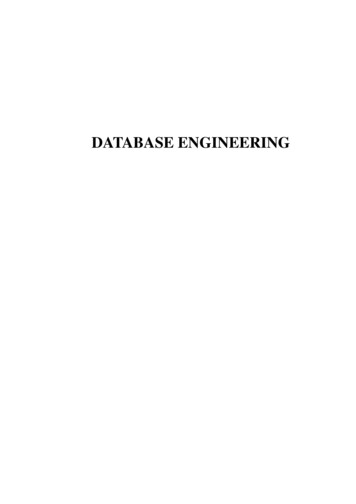
![Database Management System [DBMS] Tutorial](/img/2/dbms-tutorial.jpg)
